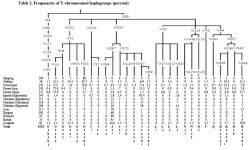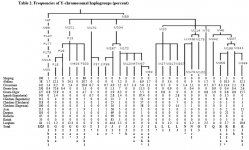Cobol19 could you please provide the source or a link for the posted percentages of Haplogroups
First of all Haplogroup R2a is absent among Gypsies the only Gypsy Group where R2a was founded , were settlers in Tajikistan originally from Germany. We can be sure that these R2a were given to this Gypsies by native Tajiks because R2a is absent among any other Gypsy group. Linking Haplogroup R2a with H is insane.and there is by far no correlation between them. I don´t know where you got this from cobol19. You sound a bit Indocentrics trying to prove that R2a and R1a did developed in India and not Central Asia.
In the two studies "Annals of Human Genetics" and "Testing hypotheses of language replacement in the Caucasus: evidence from the Y-chromosome" 16% R2a among Chechens and 8% among Ossetians was found. All scientist agree that R2a developed close to R1a somewhere in todays Tajikistan.
R2 is found throughout West-, Southwest-, South Asia, East and South Europe.
http://www.familytreedna.com/public/R2/default.aspx?section=yresults
Back to the Scythians, Medes etc. Like I mentioned sometime before allmost all
schoolers agree that a Nation called the "Medes" were the product of various North Iranic tribes.
Mede was more a title later becoming the name of a confederation. from historic records we know that Mede was also the title of many Scythians and Cimmerians. for more informations "Carola Metzner-Nebelsick: Kimmerier In: Reallexikon der Germanischen Altertumskunde,"
Many of the so called "Medes" were in fact Cimmerians and Scythians. If we look at historic records we see, that throughout the whole former Median empire there are traces of Cimmerians and Scythians-Alans. Cimmerians in Edessa, Cappadocia,Hakkari,Van and around the Zagroß. Persian records talk about Gmira(the Proto-Iranian word for Cimmerians with the meaning mobile unites, nomadic groups). There are records that South of Lak Urmiya a Region was called Gamirk the same name which was also used by the Cimmerians moving into Cappadocia. Even today this Region is called by Kurds Gawirk! This M=W/V soundshift is very typical for some Kurdish languages like Kurmanji known by any linguist. As example The North Iranian Hamin becomes Havin. Even today in this Region a Kurdish tribe lives which is called Gorani. The Word Gorani derives from Old Iranic Gairi which means Highlanders. Gairi is another Version for the Name of Cimmerians in pre historic times.
Then there are the Alans one of the biggest Kurdish tribes. Someone must be very ignorant to not see the connection between them and the Alans of Sarmatia. 99% of historians are sure that the Alan tribe among Kurds are simply the Alans(Sarmatians). The Alan tribe of Kurds live throughout Kurdistan from East Anatolia to Zagros. From Dersim, Van, Hakkari to Kirmashan you can find the Alans. unfortunately after the Dersim massacre especially members of the Alan tribe in Dersim were deported to West Anatolia to be assimilated.
a wedding of the Kurdish Alan tribe.
The Region around Sine(Sanandaj) and Mahabad is traditionally called by their People Erdalan. In Kurdish it means Erd(place, earth) Alan. The place of Alans.
Alan Kurdish dance Group from Erdalan.
The Alans also play a big role in Kurdish love stories
With regard to the Alans, we have previously mentioned the large Alanian tribal confederations among the Kurds, such as Alans of Piranshahr and Sardasht south of lake Urmia or the Alan aristocracy who ruled for centuries over what is nowadays Iranian province of Kurdistan (Ardalan, or Ard-Alan), immidiately to south of the former.
We have also referred to the name of the mythological Kurdish hero of the Epic of Mem u Zin, "Memê Alan" (or Mam the Alan). This classic love story is considered to be the épopée of the Kurdish literature. One more interesting fact with regard to the story is pointed out by the French orientalist and expert on Kurdish literature, Roger Lescot. He rightfully identified the origin of the story in a narration by Chares of Mytilene, a Greek historian of the 4th century BC. Chares informs us that the love story which is about a prince and a Scythian princess, is originally recited by the Scythians of Caucasus mountains.
the story was filmed here some excerpts. Zîn is the woman. Memê Alan(Mem the Alan) is men.
Now the thing is some people totally ignore this because they use the linguistics as reason. Those People usually have zero knowledge about the Iranic languages and how they are classified. The difference between Northwest and Northeast Iranic is super small. In fact the factors which are used for this separation are so small that simple loud shifts could effect that a Northeast Iranic language is considered Northwest. Thats why MANY linguists started to Question this system and recognized that in fact the difference between the NW and NE Iranic is smaller as that between NW and SW Iranic. Many linguists in fact do classify like this.
They put Kurdish together with the East Iranic languages in a Central Group and Persian, Kathanese have their own separate branch.
We Kurds just like any other People are the product of different tribes. The Reason why so many Kurds insist on the Median heritage, is because the forefather of Kurds were united under this title just like they are today under the term Kurd. But I don´t like it when Medes are mentioned as if it was one tribe. Med was a title used for Scythians, Parthians, Cimmerians, Alans, Mitannis and even Caucasian tribes(Hurrians) etc. and the Kurdish tribes with there diverse names are the product of this. Around Mardin there is even a Kurdish tribe called Mitan! There must be a reason why in Iranian languages Kurd means nomad as well Warrior and why Iranians almost always say "the Kurds are the real Iranians" Now the Question is, did all these tribes move into Media, or were they already present.






